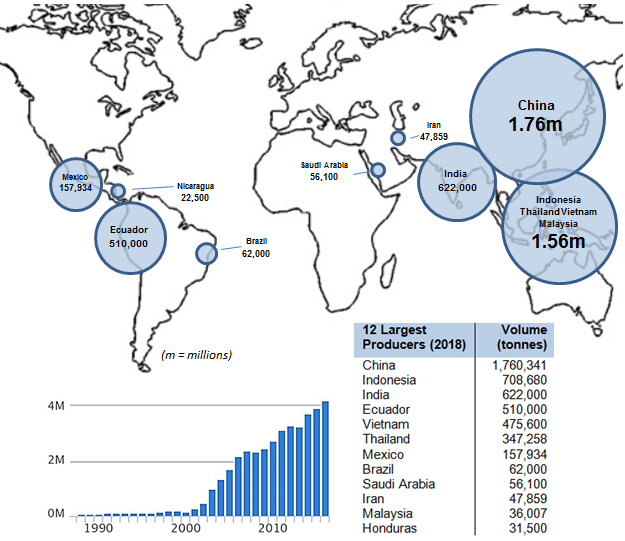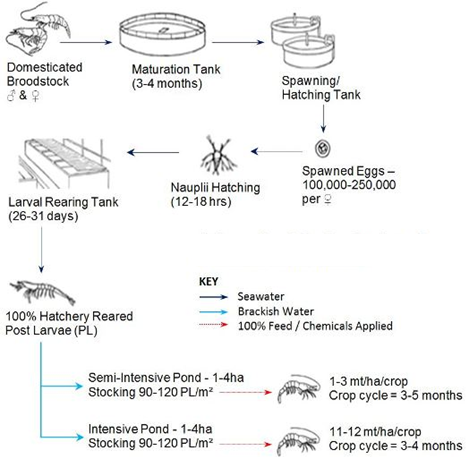White Leg Prawn
Litopenaeus vannamei
Sources, Quantities and Cultivation Methods
Sources and Quantities
The terms shrimp and prawn are used interchangeably however in this profile the term prawn is used. The two warm water prawns that dominate world markets are farmed penaeids (i.e. species from the Penaeidae family); namely the white leg prawn (Litopenaeus vannamei) and the Asian, black or giant tiger prawn (Penaeus monodon known as “monodon”). Vannamei is found in tropical marine waters. It is native to the east Pacific coastal regions (from Mexico to Ecuador) but it is also farmed outside its native range1 and across the globe, as the map illustrates.

In 2018, warm water prawns were cultured in over 40 countries, and the industry is an important source of jobs worldwide. Asia is by far the largest prawn farming region with over 80% of the production, followed by the Americas Latin America , which represents around 17%. Farmed warm water prawns are the most valuable of all aquaculture sectors, worth over US$30 billion annually2.
Vannamei dominates warm water prawn aquaculture, with over 75% of the world’s annual production (the remaining 30% is made up of monodon (15%) and minor species (10%))3. Globally vannamei farming was worth US$30 billion from a 2018 production total of some 4.96 million tonnes2.
Europe is a major market for warm water prawns, with Spain, France, Italy, the UK, Belgium, Germany, and the Netherlands accounting for 90% (€3.3 billion) of the total frozen prawn import value in 20144, 5.
Domestic Market Information
Our domestic seafood market is complex mix of products from wild caught and farmed species, including warm water prawns, which are the number one shellfish species in Great British retail (i.e. in England, Scotland and Wales). Although consumers often see all types of prawns as the same, over the past 20 years the consumption of farmed warm water prawns has significantly increased.
To discover more about the highly dynamic and ever-changing UK and Great British (GB) seafood marketplace, you can explore our user friendly and interactive Trade and Tariff in Tableau (T4) online tool. And visiting our dedicated Insight and Research pages will provide you with access to a wealth of information, from reports to factsheets on markets including:
- Retail – data from independent and multiple retailers in the UK used to reveal the latest insights on seafood eaten at home
- Foodservice – data from the foodservice industry in the UK used to highlight the latest trends on seafood eaten out of home
- Market supply – HM Revenue and Customs (HMRC) data used to detail what species and products are imported from, and exported to, the UK
To get the latest seafood market performance and trends delivered to your inbox, register at the Market Insight Portal.
Production Method
Modern warm water prawn farming began in the 1960s, became a significant industry in the 1990s, and has since grown rapidly across the world. Farms are generally located on or near the coast, and use brackish water in their ponds.
Wild vannamei spend their post-larval and juvenile stages in coastal estuaries, lagoons or mangrove areas, migrating to deeper water when they become adolescent and moving to spawning grounds as adults. Females produce as many as 100,000-250,000 eggs. Larval stages remain planktonic while tidal currents carry them towards the shore, at which point the young vannamei post-larvae become benthic, feeding on detritus, worms and small crustaceans.
Traditional pond culture of warm water prawn involved trapping and holding wild post-larvae occurring naturally in coastal zones and this practice continues6.
During the 1970s prawn breeding techniques were developed enabling hatcheries to supply on-growing farmers. The life cycle of vannamei has been fully closed and the vannamei industry worldwide relies upon domesticated broodstock as a source of post-larvae2. Specific Pathogen Free (SPF) and Specific Pathogen Resistant (SPR) vannamei are available. Suppliers can be found across the world – including the US, Thailand, Singapore and Indonesia, shipping broodstock and post-larvae to where they are needed7, 8.
Quality and health status of post-larvae is extremely important as farmed prawns can suffer from several diseases, which can cause massive losses, both in production and value. This is perhaps best illustrated by the recent outbreak of Early Mortality Syndrome (EMS) (or Acute Hepatopancreatic Necrosis Syndrome (AHPNS)) and the subsequent slump in global production between 2012 and 20139.
Shrimp farms typically are characterised by their intensity level i.e. production per unit area. There are three basic practices: extensive, semi-intensive and intensive pond culture, which represent low, medium and high stocking densities respectively. Generally vannamei farming is more intensive in SE Asia, as shown in the production schematic, compared to Latin America.
- Extensive and Improved-extensive cultivation is carried out using wild post-larvae either entering the ponds on the tide or purchased from collectors, or cultured post-larvae from hatcheries. Extensive ponds are large and fertilised with organic and inorganic fertilisers with a daily water exchange of 10-15%. Stocking density is low and the prawns feed on natural foods (enhanced by pond fertilisation) which are supplemented by artificial diets. Prawn yields are relatively low.
- Semi-intensive cultivation ponds are stocked at moderate densities with hatchery produced post-larvae. Water exchange is regularly carried out by pumping and aerators are used to maintain dissolved oxygen levels. Supplementary feed is provided by the farmer.
- Intensive cultivation ponds are generally small and they are stocked at higher densities. There is vigorous aeration, and regular feeding. Water exchange is limited, especially where there is risk of disease. When such closed systems are used, careful monitoring and management of water quality is required. High production harvest volumes can be achieved.

Vannamei often commands a lower market price than monodon, but advantages of farming vannamei can be larger yields produced more quickly and in less saline water, as well as better disease resistance.
Research and development is on-going to super-intensively cultivate vannamei in RAS (recirculating aquaculture systems) to enable very high production levels11. Prawns are cultivated in enclosed raceways or ponds housed in greenhouses where the water is treated and re-used. There is no effluent stream and only evaporative losses are replaced. It is claimed that these systems are cost effective and have low ecological impacts but have generally to prove themselves commercially. Vannamei are currently being cultured in the UK, to a limited but growing extent, in this kind of system12.
References
- FAO
- FAO FishstatJ
- GOAL
- CBI
- CBI
- FAO
- Kona Bay
- State of Hawaii
- FAO
- Cocker, L.M., 2014. Initial draft 'Farmed Marine Shrimp in Vietnam' for Seafood Watch
- The Fish Site
- FloGro Fresh